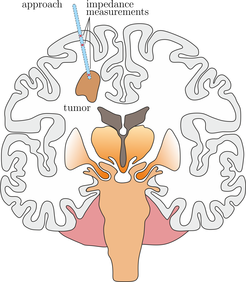Determination of the electrical properties of human brain tissue
Determining the electrical conductivity and permittivity of healthy and tumorous brain tissues through intracranial measurements in patients.
The aim of the project is to collect reliable, statistically relevant data on conductivity σ and relative permittivity ε in living human brain tissue as a function of frequency. Knowledge of these electrical properties is a prerequisite for the calculation of electric fields in the brain, needed for a number of applications, such as invasive and non-invasive brain stimulation by DBS, TMS, tACS and tDCS, the determination of the specific absorption rate (SAR) of brain tissue in the field of mobile radio, and the reconstruction of the sources of EEG and MEG.
Another goal is to investigate the possibility to use impedance measurements to differentiate between healthy and tumorous brain tissue. This differentiation is of great importance for the resection of intracerebral tumor tissue, because the extent of the resection is an important parameter for overall survival (ensuring complete resection of the tumor) as well as protection of functionally relevant brain areas (thus minimizing postoperative neurological deficits). Thus, not only the survival time but also the quality of life of patients could be improved.
In the intraoperative setting, measurements will be done in patients who have to undergo intracerebral surgery for treating an intracranial intraparenychmatic process. They will be recruited at the Department of Neurosurgery of the University Hospital Leipzig. For planning of the surgical access route and the measurement points, the 3D-MRI and CT data sets acquired for preoperative diagnostics will be used. The electric currents applied during the measurement are far below the stimulation thresholds. We use standard stimulation electrodes commonly applied during surgery and a neurostimulator approved for intraoperative neurostimulation. During measurement, the applied current and the resulting voltage response is recorded. The active measurement time is limited to a few milliseconds. In an analysis step the electrical material properties are determined with the aid of physical models and numerical simulations. The goal is to study about 100 patients within a study duration of 3 years.

Principle procedure of intracranial impedance measurement during tumor surgery. The impedances of healthy grey and white matter as well as the tumore are measured along the access route and in the target area, respectively.
